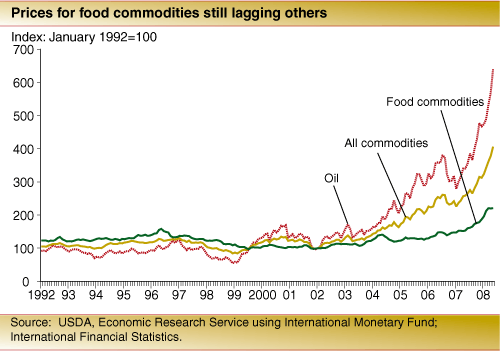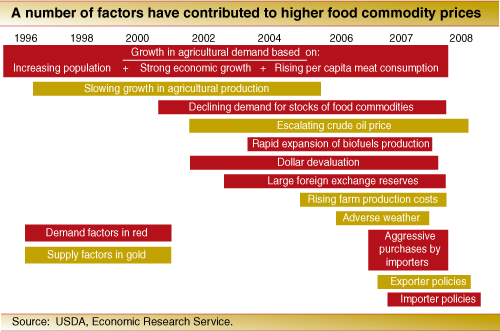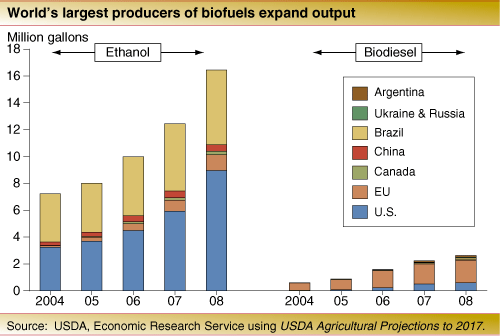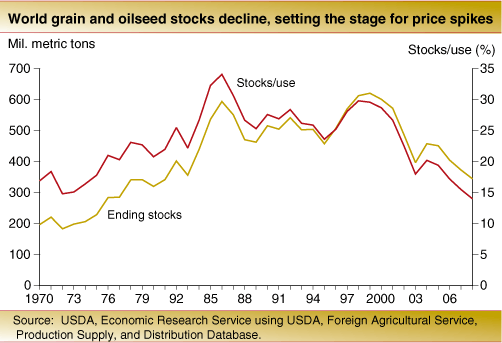Fluctuating Food Commodity Prices: A Complex Issue With No Easy Answers
- by Ronald Trostle
- 11/1/2008
Highlights
- Prices for food commodities increased sharply over the past 2 years.
- Rising food demand in developing countries outpaced production growth of major food commodities, and demand for global stockholding has fallen.
- Other factors behind higher food prices are increased energy costs, demand for biofuels, a weakening U.S. dollar, adverse weather, and policy responses by some major exporting and importing countries.
Fluctuating oil prices seem to be the issue of the day, but the cost of food commodities— particularly staples such as grains and vegetable oils—is a close second in grabbing global headlines. According to the International Monetary Fund (IMF), world market prices for food commodities rose more than 75 percent from the beginning of 2006 to July 2008.
Putting Prices Into Perspective
Rising food commodity prices over the last several years have been part of a general increase in global commodity prices, including minerals, metals, and energy. Although the food commodity index rose to a historic high over the past 2 years, the indices for all commodities, and for crude oil in particular, have significantly outpaced it. In fact, between January 2002 and July 2008, the IMF index for food commodities rose 130 percent, compared with 330 percent for all commodities and 590 percent for crude oil.
No single factor is responsible for the rapid escalation of food commodity prices. ERS has identified a set of interrelated factors that include long-term supply and demand trends, as well as more recent phenomena such as higher energy prices, increased biofuel production, depreciation of the U.S. dollar, adverse weather, and policy responses to domestic food price inflation by a number of countries.
Market Trends Have Contributed to Higher Commodity Prices
Long-term growth in worldwide demand, coupled with a slowdown in agricultural production growth, reduced global stockpiles of basic commodities like corn, soybeans, wheat, and rice. Lower stocks, in turn, made it more likely that new sources of demand, or disruptions to supply, precipitated sharply changing prices.
The rapid increase in food commodity prices did not happen overnight. On the supply side, growth in world food production was sluggish between 1995 and 2003. Stable food prices over the past 20 years and abundant global supplies reduced incentives for maintaining food stockpiles and for funding research and development to increase yields.
At the same time, strong global growth in average incomes and rising population (roughly 75 million people worldwide per year), particularly in developing countries, have increased food and feed demand. As per capita incomes rose, consumers in developing countries not only increased per capita consumption of staple foods, but also diversified their diets to include more meats, dairy products, and vegetable oils. This, in turn, amplified rising demand for grains and oilseeds used as feed.
From the Farm to the Gas Tank
Use of biofuels—fuels, like ethanol and biodiesel, made from plant material—had been modest for several decades, but production rose rapidly in the U.S. beginning in 2003 and in the European Union (EU) starting in 2005. Output increased in response to concerns about rising petroleum prices, the availability of oil supplies, and the environmental impacts of fossil fuels. The U.S. Energy Policy Act of 2005 mandated that renewable fuels used in gasoline reach 7.5 billion gallons by 2012.
This growth in worldwide biofuels demand has contributed to higher prices for biofuel feedstocks. The U.S., Brazil, and the European Union are the largest manufacturers of biofuels. Biofuel feedstocks like grains, sugarcane, soybeans, and rapeseed now have new uses beyond food and feed.
Factors Around the World Play a Role
Also underlying the historic peak in food commodity prices in 2008 was the general depreciation of the U.S. dollar after 2001. Although the dollar began to recover in the summer of 2008, its lower value meant that U.S. exports were more competitive vis-à-vis other exporters. It also meant that importers with stronger currencies had more buying power. The increased demand for U.S. food commodities from importers resulted in larger U.S. exports and contributed to higher prices in dollar terms. The dollar’s depreciation also contributed to higher dollar prices for crude oil. At the same time, farmer demand for fertilizer, fuels, and pesticides rose sharply, raising agricultural production costs and adding to the high price of food commodities.
Recent high food prices were also due in part to unusually widespread adverse weather during 2006 and 2007. Droughts, floods, high temperatures, and freezes affected agricultural yields in many countries. In 2007 alone, Northern Europe suffered harvest-time floods, while droughts enveloped Southeastern Europe, Ukraine, Russia, Turkey, and Australia. Ultimately, adverse weather caused a second consecutive drop in global average yields for grains and oilseeds, and a further decline in commodity stockpiles.
In 2006, rapidly rising agricultural commodity prices began to attract hedge, index, and sovereign wealth funds as investors sought to diversify their financial portfolios. Although the presence of funds in the commodity markets has expanded significantly in the last several years, it is unclear how this new infusion of funds has affected commodity prices or the underlying supply and demand relationships. However, the trend-following trading practices of some fund managers may have increased the volatility of agricultural prices.
Policy Response Exacerbates Situation
By summer 2007, as soybean and corn prices reached record highs, fears concerning limited global supplies prompted aggressive importing of grains and oilseeds by a number of importers, particularly those countries whose citizens are sensitive to food inflation, or countries with large foreign exchange reserves. Twenty years of abundant world food supplies and low food prices, reduced trade barriers, and high costs of storage had reduced both government and private sector food commodity reserves in many countries. The low stocks-to-use ratio for aggregate global grains and oilseeds—under 15 percent in 2008, the lowest level since 1970—prompted some large international traders, including China, India, Russia, Ukraine, and Argentina, to raise export taxes, and to restrict or ban exports of agricultural commodities, particularly grains and oilseeds. The goal was to moderate increases in retail food prices and provide domestic consumers access to such commodities.
On the demand side, major importing countries, such as the EU, India, Thailand, and Indonesia, enacted measures to restrain rising food commodity prices within their borders, but those actions also raised global import demand, causing worldwide prices to rise even more. Furthermore, a number of importers—China, Japan, other Asian countries, Russia, and some of the OPEC countries—had accumulated significant foreign currency reserves and were able to import large volumes of food commodities with little regard to record-high world prices. The result: surging import demand, at the same time that the policy responses of some major exporting countries reduced supplies on the world market.
Higher Food Prices Threaten Food Security
While recent food price inflation has affected nearly everyone, it has caused disproportional hardship and suffering among the world’s low-income population. Developing nations are particularly vulnerable to social and political unrest in response to rising food prices. Demonstrations were reported in many countries, including Pakistan, South Africa, Haiti, Morocco, Indonesia, Ethiopia, and Mexico.
For low-income, food-deficit countries, foreign donations of food aid often provide supplemental assistance to lower income consumers. Food-aid donors operate on yearly fixed budgets, which cannot readily absorb spikes in prices. Moreover, higher petroleum prices have contributed to a sharp increase in ocean freight rates, making it more costly to deliver needed food aid (see “Rising Food Prices Intensify Food Insecurity in Developing Countries,” Amber Waves, February 2008 ).
What’s Ahead: Keeping a Watchful Eye on Prices and Prospects
The future path of food commodity prices will depend on a host of complex factors. Already, crop prices have fallen from their peaks as favorable weather has fostered expectations of large 2008 harvests. Other factors that will influence prices include economic growth, energy prices (which have fallen from summer peaks), the value of the U.S. dollar, and weather in major producing countries. Thus, the movement of food prices cannot be definitively forecast. However, continued economic growth in developing nations would bolster demand and limit replenishment of low world food stocks. Further increases in petroleum prices would raise agricultural production expenses, as well as costs of transporting and processing food commodities.
According to USDA’s 10-year projections, growth in global biofuels production is expected to slow, particularly production of biofuels from grains and oilseeds. Given current U.S. ethanol policy, demand growth for ethanol-enhanced gasoline in the U.S. will slacken as the market for gasoline blended with 10-percent ethanol (commonly sold as “E10”) is satisfied. However, continuing demand for grains and oilseeds for biofuel production, combined with strong world food demand, means that global agricultural commodity prices are not expected to retreat to past levels.
Also important will be the degree to which the world’s agricultural community increases production in response to higher food commodity prices. High agricultural commodity prices raise economic incentives for expanded production through both increases in land use and gains in yields. Higher production costs can offset some of these production incentives by reducing farmers’ profits. Also, farmers without credit and other financial resources may choose to plant less or grow less input-intensive crops.
Will agricultural growers and producers worldwide adequately adjust to new farming opportunities and challenges posed by wide fluctuations in energy costs? The quality and quantity of expanded cropland, as well as water shortages and irrigation challenges, will influence future yields and output. Higher food prices could encourage producers to embrace genetically modified seeds and other types of yield-enhancing technology. And, the effects of weather on agricultural markets will continue to be important, particularly when global stocks are low, making prices more vulnerable to production shortfalls.
This article is drawn from:
- Trostle, R. (2008). Global Agricultural Supply and Demand: Factors Contributing to the Recent Increase in Food Commodity Prices. U.S. Department of Agriculture, Economic Research Service. WRS-0801.
- Westcott, P. (2008). USDA Agricultural Projections to 2017. U.S. Department of Agriculture, Economic Research Service. OCE-2008-1.
You may also like:
- Regmi, A. (2001). Changing Structure of Global Food Consumption and Trade. U.S. Department of Agriculture, Economic Research Service. WRS-01-1.
- The Future of Biofuels: A Global Perspective. (2007). Economic Research Service. in Amber Waves, Vol. 5, No. 5..





